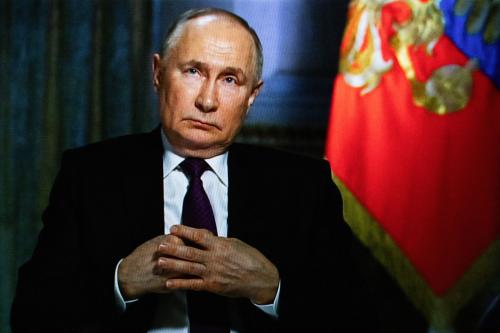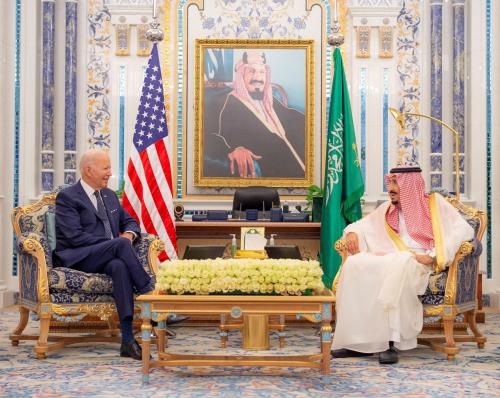Two weeks ago in Vienna, the International Atomic Energy Agency (IAEA) gave Iran until October 31 to prove it does not possess a hidden nuclear weapons program. The agency’s board demanded Iran answer a host of outstanding questions about its nuclear activities and quickly comply with requests for expanded inspections. The board’s action was widely lauded as surprisingly strong—most had expected it to issue only a weak statement, and few had thought a deadline would be imposed.
But, while the IAEA ultimatum was a tactical victory, it may be setting the stage for a strategic disaster. The IAEA’s chief goal is a more transparent Iranian nuclear program: If Iran accounts for all its nuclear materials by October 31 and agrees to give the IAEA expanded inspection authority, the agency’s board is unlikely to cite Iran for breaching the Nuclear Non-Proliferation Treaty (NPT)—despite overwhelming evidence of violations. Unfortunately, transparency is not enough to prevent Iran from developing a nuclear bomb. A clean bill of health from the IAEA would leave Iran’s entire nuclear effort intact, and, although the agency would closely monitor the country for signs of a weapons program, the most difficult step in building a nuclear arsenal—making enough plutonium or highly enriched uranium—can be taken under the guise of a legal, “peaceful” energy program. If it plays its cards right, Iran, with the IAEA as unwitting enabler, could thus pursue a nuclear weapons program with little interference, simply ejecting IAEA inspectors and perhaps withdrawing from the NPT before actually building any weapons—a process that could take only a matter of weeks once it has enough fissile material.
Ever since Iran renewed active pursuit of nuclear power in 1995, the United States has been rightly suspicious that the effort was intended primarily as cover for an illicit nuclear weapons program. But the U.S. case was entirely circumstantial and largely inferential; until recent months, there was no proof of Iran’s deceit around which the United States could build an international consensus for action. In the summer of 2002, though, a dissident group called the National Council of Resistance of Iran revealed that Tehran was pursuing a secret nuclear development program—specifically, that it was building a heavy-water production plant in Arak and a uranium-enrichment facility in Natanz. Since then, officials from the IAEA have engaged in a painstaking process of inspections and analysis, attempting to uncover the true nature and extent of the Iranian effort. Iranian officials have been disturbingly uncooperative. Inspectors have been denied access to essential sites, only to be granted entry after those facilities had been thoroughly cleaned of potentially incriminating evidence. And Iran has met IAEA questioning with a series of contradictory explanations.
In late August, those contradictions were catalogued in an IAEA report providing overwhelming evidence that Iran has lied about its nuclear program and broken its NPT obligations. Yet, when the IAEA board met two weeks ago in Vienna, it did not accuse Tehran of illegal activity—it simply issued the October 31 deadline. Had the IAEA declared Iran in noncompliance with its treaty obligations, it would have forced the U.N. Security Council to take up the Iranian case, improving U.S. leverage and increasing pressure on Tehran to give up its most threatening nuclear technologies. Instead, the IAEA essentially affirmed that, if Iran agrees to develop its supposed power program openly, it will whitewash Tehran’s past violations, allowing that country’s ruling mullahs to continue to accumulate the materials and technology they need to build nuclear weapons. If the IAEA fails to take advantage of the current opportunity to bring Iran’s violations to the Security Council, the very organization responsible for monitoring the NPT will have provided cover to a state seeking a nuclear arsenal.
At the last IAEA board meeting in June, delegates were presented with evidence that Iran had secretly imported 1,800 kilograms of uranium from China—uranium it had been required, under the NPT, to declare; they were told of a welldeveloped uranium-enrichment program, which suggested that Iran had previously tested centrifuges with uranium, in clear contravention of its NPT obligations; and they learned of Iranian plans to build a plutonium-production reactor based on heavy-water technology, which could provide material for nuclear weapons. But Iran offered explanations for all these findings: Officials claimed they’d been unaware of their obligation to report the uranium imports; insisted they had used inert gas, not uranium, to test their centrifuges; and said they planned to use their plutoniumproduction reactor to produce medical materials, such as radioisotopes used to diagnose cancer. These arguments, while not entirely convincing, were plausible enough to deflect international concern.
Since the June meeting, however, the IAEA has uncovered abundant evidence that the Iranian explanations are, in fact, false. A report delivered in late August by IAEA Director General Mohamed ElBaradei to the IAEA board asserts that “some of the information [provided by Iran] was in contrast to that previously provided by Iran.” Translation: Either Iran was lying before, or it’s lying now—or both. That conclusion lends significant weight to U.S. suspicions of a clandestine nuclear weapons program and makes it essential that the international community act before Iran proceeds further.
There are several key inconsistencies in Iran’s explanations of its nuclear activity. In June, the IAEA reported Iran’s explicit denial that it had used its covertly imported uranium to perform “conversion experiments,” which change the chemical or physical form of uranium and are an essential component of an enrichment program. According to the new report, however, Iran has now admitted to conducting precisely those types of experiments. The report also notes that Iran has thus far been unable to satisfactorily explain the disappearance of 1.9 kilograms of its imported uranium, which many suspect has been used in enrichment experiments. Initially, Iran simply claimed the uranium had leaked through a defective valve, but IAEA tests called that explanation into question. Now, to maintain the story’s technical credibility, Iran has claimed that the uranium was stored in a room where temperatures exceeded 130 degrees Fahrenheit, roughly the temperature at which uranium hexafluoride—the form in which the uranium was stored—becomes a gas and can leak. That story strains credulity given that outdoor temperatures in Iran don’t reach 130 degrees and, while indoor temperatures theoretically could, Iran has offered no explanation for why it would store such precious material so carelessly.
The IAEA also rejects Iran’s explanations of how it tested its centrifuges without using uranium—and with good reason. Originally, Iran claimed to have used inert gas in testing but now says it did not test the centrifuges at all and instead relied on computer simulations and technical data from drawings purchased abroad. But Iran has failed to produce original copies of the drawings. And, regardless, according to the IAEA, “It is not possible to develop enrichment technology, to the level seen at Natanz, based solely on open-source information and computer simulations, without process testing with [uranium].” While the IAEA is not explicit, the implication is clear: Iran has tested its centrifuges using uranium—a clear violation of the NPT—and is now trying to cover it up.
Investigation of Iran’s plans for a plutonium-production reactor has revealed inconsistencies, too. To use the reactor to make medical materials—Iran’s stated intent—Iran would need to build “hot cells,” lead-lined devices where used reactor fuel could be manipulated to extract the medically useful materials. This past summer, at the IAEA’s request, Iran submitted design plans for its plutonium-production reactor, but they included no references to hot cells. As the IAEA notes, this is “contrary to what would be expected given the radioisotope production purposes of the facility,” implying that Iran has fudged its documents. Why would it do that? Perhaps because hot cells can also be used to extract plutonium for nuclear weapons, and Iran thought that, by leaving hot cells out of its designs, it could avoid suspicions about its work. According to the IAEA, “Iran has been asked to look into this matter further,” a polite way of suggesting that Iran tell the truth.
Despite the implications of last week’s resolution, it is too late for Iran to put this matter to rest with further explanations. It has already had that opportunity—and has instead lied. In November, the IAEA board should cite Iran for its past noncompliance with the NPT, automatically sending the matter to the Security Council—regardless of what Iran does before the October 31 deadline. The IAEA appears hesitant to do that, probably because it would eliminate the agency’s chance to expand its inspection powers in Iran. But, while inspections may be useful, they are not an end in themselves. They are a tool to monitor compliance and ferret out wrongdoing—which is exactly what they have done.
Now it is time for the IAEA to turn the question of how to deal with an NPT violator over to the Security Council. Options would range from demanding Iran terminate parts of its nuclear program (uranium enrichment would be a good place to start) to imposing economic sanctions or even eventually to authorizing military action to destroy the Natanz enrichment plant. But, if instead the IAEA declines to cite Iran’s violations, it will give political cover to those, such as Russia or China, who may be inclined to deny that a serious problem exists. Without international action to contain it, Iran’s nuclear program will proceed apace, spurring an atomic race in the region, fracturing nonproliferation firewalls, and increasing the prospect that nuclear weapons could fall into terrorists’ hands. If the IAEA gives Iran a clean bill of health in November and any of these eventualities comes to pass, the agency will have much to answer for.



Commentary
Enabler: The IAEA Must Be Careful with Iran
October 6, 2003